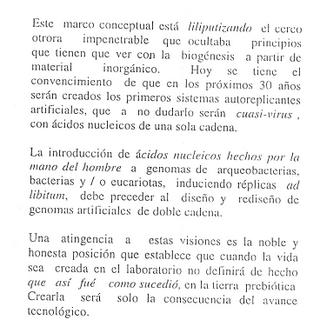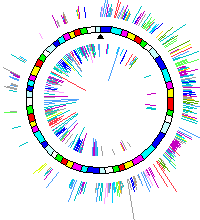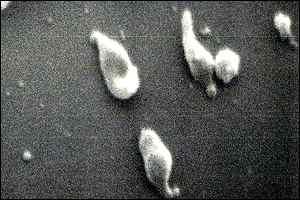Creando vida nueva y, hasta artificial.

En el año 2000, pleno de ilusiones presenté al Jefe de Proyectos de investigación, de una Universidad peruana, un proyecto -que incluía la publicación de un libro de 63 páginas, en formato reducido. Los 3 párrafos de la izquierda corresponden a extractos (página 5), introductorios del mismo. Titulé al proyecto : "El origen de la vida", siendo los temas tratados, los siguientes : :1-Orden, del desorden 2-Autocopias 3-que somos? 4.Exobiologia 5-Vida alterna 6-De donde venimos?.El último ancestro común de la vida 7-De lo inorgánico a lo orgánico 8-Los eslabones y, 9-A donde vamos :Un genoma de novo.
Como Ustedes podrán leer, en los párrafos mostrados, yo planteba desde entonces la .."génesis de sistemas autoreplicantes artificiales : cuasi virus y de ácidos nucleicos de una sola cadena.."

El tema viene a colación en tanto Craig Venter (a la derecha), acaba de plantear lo mismo, pero no yá, a nivel de virus, sino a nivel de estructuras más complejas. Craig, una fuerza de la naturaleza en el mundo de la investigación, anhela crear bacterias. Así de simple : vida nueva, vida artificial.
En la actualidad, El tema de genesis de vida artificial, yá no es tan nuevo,porque el año 2002, se ensambló el primer virus sintético, en Stony Brook -Universidad de Nueva York-, empleando secuencias genómicas parciales del virus de la poliomielitis. El año 2003 Venter, sintetizó un genoma artificial, creando el bacteriófago : phiX174. Este año (2005), se ha empezado incluso a prescindir de la estructura celular, reemplazándola por vesículas sintéticas (como lo sugiriera el ruso Oparin en 1925), que pueden procesar los genes, del mismo modo que las bacterias.

Seuencia genética del M.genitalium. Removiendo segmentos coloreados (genes), e insertando otros naturales o artificiales, en su lugar, es posible crear nuevos virus y con el tiempo... hasta dinosaurios.
Creating new life and, until artificial.
In 2000, total one of illusions I presented to the the Head of Projects of investigation, of a Peruvian University, a project - that included the publication of a book of 63 pages, in reduced format. The 3 paragraphs of the left correspond to extracts (page 5), of introduction of the same one. I titled the project: "The origin of life", being the treated subjects, the following ones: :1- Order, of disorder 2- Autocopyes 3- What we are? 4-Exobiology 5- Life alternates 6- Where we come from?. The last ancestral common of life 7-Of the inorganic thing to organic life 8- the links and, 9- Where we go: A new genome.
The book project was written with transcendental logic (almost críptic for some) and the style was evolucionist. Other this to say that the project, nor the book were accepted. They said to me that that it was not investigation. What it did not let me worry, because Einstein, Ramanujan and others, worked single with pencil and paper and, very efficiently.
As You can read, in the shown paragraphs, I wrote, the "génesis of artificial self-replicants systems: cuasi virus and of nucleics acids of a single chain."
The subject comes inasmuch Craig Venter (to the right), finishes raising the same, but not already, at level of virus, but at level of more complex structures. Craig, a force of the nature in the world of investigation, yearns for to create bacteria. That simple: new life, artificial life.At the present time, the subject of genesis of artificial life, already is not so new, because year 2002, assembled the first synthetic virus, in Stony Brook - University of New York -, using partial genomic sequences of the virus of the poliomielitis. The year 2003 Venter, synthesized an artificial genome, creating the bacteriophage : phiX174. This year (2005), has begun to even do without the cellular structure, replacing it by synthetic vesicles (as suggested the Russian Oparin in 1925 in the same way), that can process the genes, that the bacteria.
For some who know the subject, the génesis of artificial life (creation of new life), does not call to surprise. To create new virus is a simple task. It is like the work of a mechánics:cuts, amplification of segments, joint them and much mathematical one. Being easy to construct new virus, they can be used in biological wars.
Visionary Venter, wants to construct a bacterium that has minimal number of genes. Also, he wishes synthesize genetic material and insert it in a vacuum cell. He wants to happen from to read the genomic code, to write it. For it he wants to replace some of the 517 genes of Mycoplasma genitalium (to the right). In this eagerness, he is removing gene by gene of M.genitalium, to determine the minimal number of genes with which this germ, can fight with the stress of the enviromment.
Venter thinks that altering photosinthetics pathways of the new bacteria to create, new forms of energy will be identified. Thank to the new bacteria, it will be possible recycle radioactive substances, eliminate toxic substances, fight against pollution, extract hydrogen to connect it to electrical cells, eliminate CO2, avoiding global overheating. At the moment, Venter amplifies the genetic sequences by means of the chain reaction of the polymerase and link genes with the linking technique of the ciclic polymerase. The possibility does not escape to Venter of constructing synthetic genomes (creating complex forms of life ). Very similar to which this humble writer pretended to publish the year 2000.Genetic Sequence of M.genitalium. Removing colored segments (genes), and inserting natural and artificial genes in his place, it is possible create new virus and with time, until dinosaurs.




.+Photo+Author.jpg)



1 Comments:
Looking for information and found it at this great site... » »
Post a Comment
<< Home